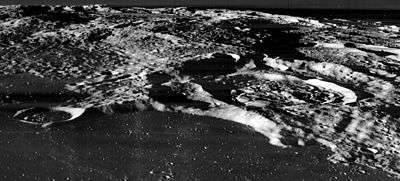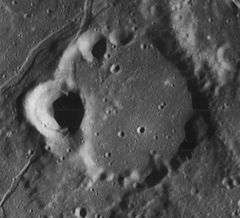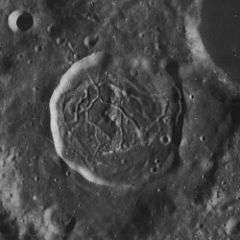Damoiseau (crater)
|
Lunar Orbiter 4 image | |
| Coordinates | 4°48′S 61°06′W / 4.8°S 61.1°WCoordinates: 4°48′S 61°06′W / 4.8°S 61.1°W |
|---|---|
| Diameter | 37 km |
| Depth | 1.2 km |
| Colongitude | 61° at sunrise |
| Eponym | Marie-C.-T. de Damoiseau |
Damoiseau is a lunar crater that is located just to the west of the Oceanus Procellarum, in the western part of the Moon's near side. It lies due east of the prominent crater Grimaldi, a walled plain with a distinctive dark floor. Due south of Damoiseau is the crater Sirsalis.
The low outer rim of Damoiseau is not quite circular, having an outward protrusion to the northeast and smaller bulges to the north and southeast. The interior floor is irregular and complex, with a series of ridges and small clefts (similar to Vitello). The crater is concentric with a larger, older crater designated Damoiseau M[1] that is approximately twice the diameter. This outer feature is missing a rim to the northeast where it intersects the lunar mare.
To the southeast is a rille system named the Rimae Grimaldi. This continues to the west and south, for a maximum dimension of 230 kilometers.
Satellite craters
By convention these features are identified on lunar maps by placing the letter on the side of the crater midpoint that is closest to Damoiseau.
| Damoiseau | Latitude | Longitude | Diameter |
|---|---|---|---|
| A | 6.3° S | 62.4° W | 47 km |
| B | 8.6° S | 61.6° W | 23 km |
| BA | 8.3° S | 59.0° W | 9 km |
| C | 9.1° S | 62.5° W | 15 km |
| D | 6.4° S | 63.3° W | 17 km |
| E | 5.2° S | 58.3° W | 14 km |
| F | 7.9° S | 62.1° W | 11 km |
| G | 2.5° S | 55.6° W | 4 km |
| H | 3.8° S | 59.8° W | 45 km |
| J | 4.1° S | 62.0° W | 7 km |
| K | 4.6° S | 60.4° W | 23 km |
| L | 4.5° S | 59.3° W | 14 km |
| M | 5.1° S | 61.3° W | 54 km |


References
- ↑ Damoiseau M, Gazetteer of Planetary Nomenclature International Astronomical Union (IAU) Working Group for Planetary System Nomenclature (WGPSN)
- Andersson, L. E.; Whitaker, E. A. (1982). NASA Catalogue of Lunar Nomenclature. NASA RP-1097.
- Blue, Jennifer (July 25, 2007). "Gazetteer of Planetary Nomenclature". USGS. Retrieved 2007-08-05.
- Bussey, B.; Spudis, P. (2004). The Clementine Atlas of the Moon. New York: Cambridge University Press. ISBN 978-0-521-81528-4.
- Cocks, Elijah E.; Cocks, Josiah C. (1995). Who's Who on the Moon: A Biographical Dictionary of Lunar Nomenclature. Tudor Publishers. ISBN 978-0-936389-27-1.
- McDowell, Jonathan (July 15, 2007). "Lunar Nomenclature". Jonathan's Space Report. Retrieved 2007-10-24.
- Menzel, D. H.; Minnaert, M.; Levin, B.; Dollfus, A.; Bell, B. (1971). "Report on Lunar Nomenclature by the Working Group of Commission 17 of the IAU". Space Science Reviews. 12 (2): 136–186. Bibcode:1971SSRv...12..136M. doi:10.1007/BF00171763.
- Moore, Patrick (2001). On the Moon. Sterling Publishing Co. ISBN 978-0-304-35469-6.
- Price, Fred W. (1988). The Moon Observer's Handbook. Cambridge University Press. ISBN 978-0-521-33500-3.
- Rükl, Antonín (1990). Atlas of the Moon. Kalmbach Books. ISBN 978-0-913135-17-4.
- Webb, Rev. T. W. (1962). Celestial Objects for Common Telescopes (6th revised ed.). Dover. ISBN 978-0-486-20917-3.
- Whitaker, Ewen A. (1999). Mapping and Naming the Moon. Cambridge University Press. ISBN 978-0-521-62248-6.
- Wlasuk, Peter T. (2000). Observing the Moon. Springer. ISBN 978-1-85233-193-1.
